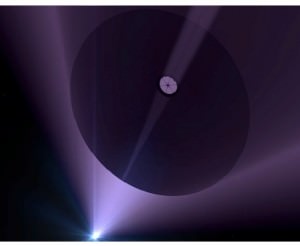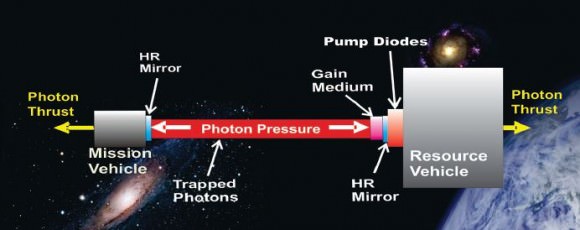We’ve achieved amazing things by using chemical rockets to place satellites in orbit, land people on the Moon, and place rovers on the surface of Mars. We’ve even used ion drives to reach destinations further afield in our Solar System. But reaching other stars, or reducing our travel time to Mars or other planets, will require another method of travel. One that can approach relativistic speeds.

The system is called DEEP IN, or Directed Propulsion for Interstellar Exploration. The general idea is that we have achieved relativistic speeds in the laboratory, but haven’t taken that technology—which is electromagnetic in nature, rather than chemical—and used it outside of the laboratory. In short, we can propel individual particles to near light speed inside particle accelerators, but haven’t expanded that technology to the macro level.
Directed Energy Propulsion differs from rocket technology in a fundamental way: the propulsion system stays at home, and the craft doesn’t carry any fuel or propellant. Instead, the craft would carry a system of reflectors, which would be struck with an aimed stream of photons, propelling the craft forward. And the whole system is modular and scalable.

If that’s not tantalizing enough, the system can also be used to deflect hazardous space debris, and to detect other technological civilizations. As talked about in this paper, detecting these types of systems in use by other civilizations may be our best hope for discovering those civilizations.
There’s a roadmap for using this system, and it starts small. At first, DEEP IN would be used to launch small cube satellites. The feedback from this phase would then inform the next step, which would be to test a unit for defending the ISS from space debris. From then, the systems would meet goals of increasing complexity, from launching satellites to LEO (Low-Earth Orbit) and GEO (Geostationary Orbit), all the way up to asteroid deflection and planetary defense. After that, relativistic drives capable of interstellar travel is the goal.
There are lots of questions still to be answered of course, like what happens when a vehicle at near light-speed hits a tiny meteorite. But those questions will be asked and answered as the system is developed and its capabilities grow.
Obviously, DEEP IN has the potential to bring other stars into reach. This system could deliver probes to some of the more promising exo-planets, and give humanity its first detailed look at other solar systems. If DEEP IN can be successfully scaled up, as Lubin says, then it will be a transformational technology.
Here’s a longer video of Dr. Lubin explaining DEEP IN in greater depth and detail: http://livestream.com/viewnow/niac2015seattle
Here’s the website for the University of California Santa Barbara Experimental Cosmology Group: http://www.deepspace.ucsb.edu/


!
I need to hear more about how to slow down….
Plug the laser in backwards! 😉
Well, if you’re going to a planet with an atmosphere you can aerobrake (or lithobrake if your aim is off). Otherwise you can detach the larger part of your reflectors and use them to bounce the drive beam back against the payload, braking the payload while accelerating off into oblivion.
Obviously you’d have to build a “receiver” on the target object first.
Maybe we should get a scale version and do a few things closer to home.
1) Put an orbiter around a few bodies – Pluto, Sedna, Eris, Makemake…. Get one out to Saturn since Cassini is ending soon.
2) Find and tag Pioneer 10 with a radio setup to keep track of it in the years ahead since it is on the way to the aphelion direction of P9 (though it could still miss P9 by a large margin.)
3) Hard-land a probe ahead of New Horizon’s targets to coordinate its approach and science as well as some other targets way out there.
So you’re on a ship with no propellant approaching Mars at “relativistic speed”. Is the surface of the planet the break ?
This laser would potentially be a fearsome weapon.
@Hematite – which is the ONLY reason it will get funding.
I assume this would require installing another laser on the surface of Mars, both to slow down the craft for the second half of the flight, and to propel the return trip. Sounds very intriguing.
Perhaps on one of the martian moons.
This is an old idea. Older than Apollo. Robert Forward articulated the idea of pushing light sails via lasers way back in the 1960’s. Long story short, the power requirements for using it as a method for interstellar travel are comically impractical. Hundreds of terawatts. Many times more than the power consumption of the entire planet.
How does this differ from solar sails?
The sails in this case may be much smaller as the laser projector power can be dialed up way much more than the intensity of solar rays.
Hi Evan, you wrote “which he thinks could reduce the travel time from Earth to Mars to just 3 days, for a 100 kg craft”. OK, a 1000 kg craft like curiosity will take 30 days to reach Mars. Then for a manned mission (at least 3-4 member crew) it may be around 50 tonnes and how long it may take to reach Mars? could you please explain? thanks.